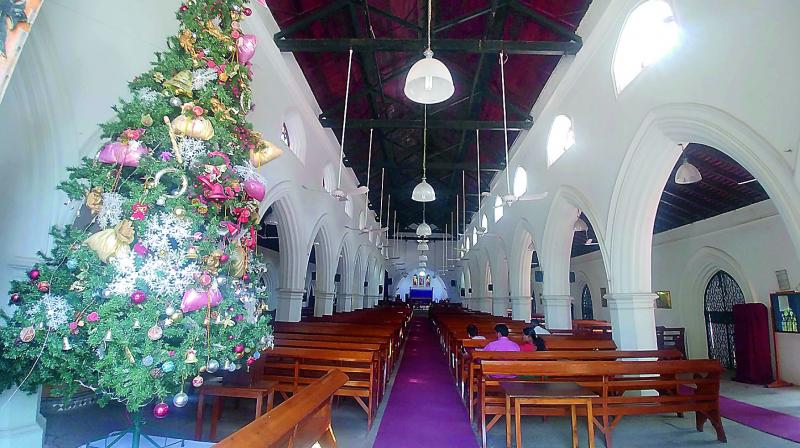All Saints Church in Secunderabad was meant to serve British soldiers

Hyderabad: The Cantonment area in Secunderabad is fairly well-planned with lots of greenery and old buildings, which includes the All Saints Church, constructed in 1860 to serve the British soldiers.
This church was the first permanent structure in the Trimulgherry entrenchment and was a garrison church with Army chaplains conducting the services. It was later handed over to the Church of South India in 1947. Hence this church has both English and Tamil services.
In 1983, Queen Elizabeth II visited the church though she celebrated her 36th wedding anniversary, along with Prince Philip, at the nearby Holy Trinity Church at Bolarum. After a century and a half, the church was showing signs of wear and tear. Devotees found that this 157-year-old church was developing cracks with the teak rafters supporting the roof getting weak. While the turrets were also developing cracks, the original lime plaster had gotten chipped off from the walls.
Worshippers in 2011 felt that if restoration was not done at the earliest then this pink Anglican beauty would simply fade away and remain a mere memory.
Finally, it was renovated and restored to its original form in 2012 and all this was not done with the help of a philanthropist or donations, but it came from the congregation.
A series of meetings were held where it was sensibly decided that to maintain the old glory of the church, restoration was the only way as opposed to demolition and rebuilding. Luckily, that decision has kept heritage to this place as the old pews sit in the sun-dappled glory on a winter morning even as devotees come to pray in the quiet and vaulted hall of the church. Fans with twisted edges hang from the teak rafters. A huge Christmas tree at the entrance competes with the tall door for height and lends a festive feeling while the church is being given a good wash, allowing that unique pink colour of the church to let off a healthy glow.
Rev. D. Justus Moni returned to All Saints Church for the third time. Between 1986 and 1989 they had started a school to coincide with the 125th anniversary of the church, but unfortunately it was closed down. And then Rev. Moni was there from 2008 to 2010 when the congregation was worried about the status of the church. He was part of all the discussions when it was decided to restore the church. “That is because amongst the devotees there is a lot of respect for heritage,” he said. He is here now once again, leading his devotees.
Even from the road, this church looks imposing with the many turrets, standing tall in the old Gothic style with stately columns, splendid arches, massive buttresses and majestic spires. The old furniture has been kept and so the antique pews look clean and shiny. The pulpit and the lectern are from yesteryear as the mosaic floor which leads to the altar where a beautiful stained glass window shimmers in the dull sunlight. A smaller stained glass of a different shape is right above the altar, known as the Rose window. Apparently, the stained glass window is dedicated to Edward Dawson, Lieutenant of the Royal Artillery in 1884.
This was originally a church for the British soldiers is reflected from the various brass memorials hung on the walls around the church with the names of the soldiers. The church received the INTACH Heritage Award from the government of Andhra Pradesh for good maintenance in 2002.
There is also a baptismal font, probably the only one in the city of that time and age. While this one might be for kids, there is a larger one right at the entrance, which looks ordinary with its municipal swimming pool looks, a mini version, though.
“We held a meeting and it was decided to take the help of APTSORBH (Agency for Providing Traditional Solutions and Restoration of Built Heritage), a Tamil Nadu-based firm which is behind the restoration of many old buildings, including the St. Mary’s Church. It took 18 months of highly skilled work before the church once again came back to its old form,” says Rev. Moni.
The restoration was done using fresh lime plaster and little cement. Using traditional materials such as aloevera, eggs, jaggery and indigafera tinctoria also known as true Indigo, a mixture was applied over the lime-plastered surface.
While the whole side roof was re-laid, the entire main roof was replaced and the rafters eaten by termites re-laid, while the 100-year old windows and main doors were polished. The ventilators are charming, allowing light to enter through its clean glass. There is a lot of light and good circulation of air, considering this entire church is surrounded by greenery.
“I do not know the exact amount spent in restoring the church, but the congregation and some well-wishers from other churches paid more than Rs 1 crore,” says Rev. Moni. While on week days there are no services, devotees can come and spend time in communion with the Lord. It is quiet and conducive for praying. On Sundays, there are three services with two in English and one in Tamil.

